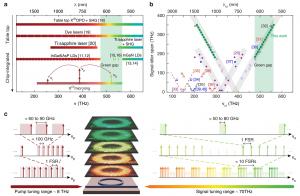Multispectral Smart Window: A Step Towards Healthier Indoor Environments
GA, UNITED STATES, September 4, 2024 /EINPresswire.com/ -- Green-gap lasing is a grand challenge that nonlinear nanophotonics has promise to address. Our research advances this by using Kerr optical parametric oscillation in silicon nitride microrings, pumped with a tunable 780 nm laser, to access the entire green gap (532-633 nm). We generated > 100 wavelengths with continuous tuning > 50 GHz and < 1 MHz optical linewidths by only 4 devices. This breakthrough in nonlinear nanophotonics opens new possibilities for visible spectrum applications.
Green light lasers have long been a challenging frontier for scientists, particularly in the context of compact, chip-scale sources. This challenge is commonly known as the “green gap” problem. While ample progress has been made in generating blue and red semiconductor diode lasers, creating efficient and compact green lasers has been a grand challenge for laser communities. In particular, a single-mode, narrow-linewidth, widely-tunable laser covering the green gap is highly desired in many quantum computing and sensing systems, biological imaging and spectroscopy, and underwater communication, but has yet to be demonstrated.
In a new paper (doi: https://doi.org/10.1038/s41377-024-01534-x) published in Light Science & Applications, a team of scientists from the Joint Quantum Institute (JQI) of NIST and the University of Maryland, led by NIST/JQI fellow Kartik Srinivasan, has managed to bridge this gap using nonlinear nanophotonics. By leveraging Kerr optical parametric oscillation (OPO) in high-quality factor silicon nitride microrings, researchers have successfully accessed the entire green light spectrum, covering wavelengths from 532 to 633 nm. This advancement opens a realm of possibilities for various applications in science and industry.
Utilizing sophisticated microring geometries, scientists engineered a novel approach that enables precise control over light wavelengths. By fine-tuning silicon nitride microrings and partially undercutting the microring structure, they managed to expand wavelength access robustly. Pumped with tunable near-infrared laser light near 780 nm, the devices generated over 100 unique laser wavelengths within the green gap using only 4 devices, demonstrating continuous frequency tuning > 50 GHz and narrow optical linewidths < 1 MHz. “Our design opens up much broader wavelength access in green, and moreover, with more robust generation because of its flatter dispersion.” Says Xiyuan Lu, a scientist in Srinivasan’s group “This robust access to a broad set of wavelengths is crucial for applications in spectroscopy, quantum technology, and medical practices.”
Exploring the intricacies of silicon nitride microresonators, researchers discovered efficient and scalable methods to manipulate light. “By varying the geometry and also employing a dispersion engineering trick by partially undercutting the microring structure, we can control the emitted wavelengths quite accurately.” Yi Sun, a scientist at University of Maryland, says, “The devices are in the silicon nitride nanophotonics platform, which is quickly accessing foundry fabrication capabilities for product scale-up.” This technology paves the way for future innovations in photonics, where compact, efficient, and tunable light sources can be integrated into various devices, drastically improving their functionality and performance.
This groundbreaking work marks an important milestone in the quest to conquer the green gap. With enhanced robustness and precision, Kerr OPO devices stand ready to revolutionize nonlinear nanophotonics, bringing its benefits into the visible spectrum. “A single device covering the green gap is around the corner, with the collective efforts of the nanophotonics community.” Says Jordan Stone, a NIST scientist and co-first author of this paper. “We are also optimistic to increase the output power and continuous mode-hop free tuning range.” As technology continues to be refined and new applications explored, the impact of this research will be felt across multiple domains, serving both fundamental science in quantum sciences and commercial productization with integrated lasers.
DOI
10.1038/s41377-024-01534-x
Original Source URL
https://doi.org/10.1038/s41377-024-01534-x
Funding information
This work is supported by the DARPA LUMOS program, NIST-on-a-chip program, and Maryland Innovation Initiative.
Lucy Wang
BioDesign Research
email us here
Legal Disclaimer:
EIN Presswire provides this news content "as is" without warranty of any kind. We do not accept any responsibility or liability for the accuracy, content, images, videos, licenses, completeness, legality, or reliability of the information contained in this article. If you have any complaints or copyright issues related to this article, kindly contact the author above.

